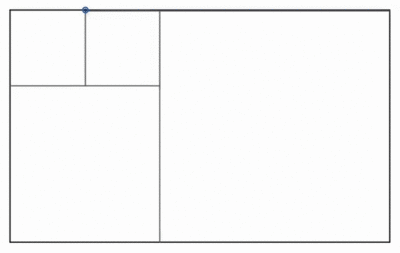2020 AMC 8 Problems/Problem 25
Contents
[hide]- 1 Problem
- 2 Solution 1
- 3 Solution 2
- 4 Solution 3 (faster version of Solution 1)
- 5 Solution 4
- 6 Solution 5 (Cheese)
- 7 Video Solution by Math-X (First understand the problem!!!)
- 8 Video Solution(🚀Just 1 min🚀)
- 9 Video Solution
- 10 Video Solution by OmegaLearn
- 11 Video Solution by WhyMath
- 12 Video Solution by The Learning Royal
- 13 Video Solution by Interstigation
- 14 Video Solution by STEMbreezy
- 15 See also
Problem
Rectangles ![]() and
and ![]() and squares
and squares ![]() and
and ![]() shown below, combine to form a rectangle that is 3322 units wide and 2020 units high. What is the side length of
shown below, combine to form a rectangle that is 3322 units wide and 2020 units high. What is the side length of ![]() in units?
in units?
![[asy] draw((0,0)--(5,0)--(5,3)--(0,3)--(0,0)); draw((3,0)--(3,1)--(0,1)); draw((3,1)--(3,2)--(5,2)); draw((3,2)--(2,2)--(2,1)--(2,3)); label("$R_1$",(3/2,1/2)); label("$S_3$",(4,1)); label("$S_2$",(5/2,3/2)); label("$S_1$",(1,2)); label("$R_2$",(7/2,5/2)); [/asy]](http://latex.artofproblemsolving.com/a/5/5/a55c518a1179d67520c6a03827b4ba25ca1413f2.png)
![]()
Solution 1
Let the side length of each square ![]() be
be ![]() . Then, from the diagram, we can line up the top horizontal lengths of
. Then, from the diagram, we can line up the top horizontal lengths of ![]() ,
, ![]() , and
, and ![]() to cover the top side of the large rectangle, so
to cover the top side of the large rectangle, so ![]() . Similarly, the short side of
. Similarly, the short side of ![]() will be
will be ![]() , and lining this up with the left side of
, and lining this up with the left side of ![]() to cover the vertical side of the large rectangle gives
to cover the vertical side of the large rectangle gives ![]() . We subtract the second equation from the first to obtain
. We subtract the second equation from the first to obtain ![]() , and thus
, and thus ![]() .
.
Solution 2
Assuming that the problem is well-posed, it should be true in the particular case where ![]() and
and ![]() . Let the sum of the side lengths of
. Let the sum of the side lengths of ![]() and
and ![]() be
be ![]() , and let the length of square
, and let the length of square ![]() be
be ![]() . We then have the system
. We then have the system ![]() which we solve to determine
which we solve to determine ![]() .
.
Solution 3 (faster version of Solution 1)
Since, for each pair of rectangles, the side lengths have a sum of ![]() or
or ![]() and a difference of
and a difference of ![]() , the answer must be
, the answer must be ![]() .
.
Solution 4
Let the side length of ![]() be s, and the shorter side length of
be s, and the shorter side length of ![]() and
and ![]() be
be ![]() . We have
. We have
![[asy] draw((0,0)--(5,0)--(5,3)--(0,3)--(0,0)); draw((3,0)--(3,1)--(0,1)); draw((3,1)--(3,2)--(5,2)); draw((3,2)--(2,2)--(2,1)--(2,3)); label("$R_1$",(3/2,1/2)); label("$S_3$",(4,1)); label("$S_2$",(5/2,3/2)); label("$S_1$",(1,2)); label("$R_2$",(7/2,5/2)); label("$r$",(5.2,5/2)); label("$r$",(3.2,1/2)); label("$s$",(3.2,3/2)); [/asy]](http://latex.artofproblemsolving.com/0/7/a/07a5439c40e473c7c550108923c205e886027cfd.png)
From this diagram, it is evident that ![]() . Also, the side length of
. Also, the side length of ![]() and
and ![]() is
is ![]() . Then,
. Then, ![]() . Now, we have 2 systems of equations.
. Now, we have 2 systems of equations.
![]()
We can see an ![]() in the 2nd equation, so substituting that in gives us
in the 2nd equation, so substituting that in gives us ![]() .
.
Solution 5 (Cheese)
Note that the problem is underspecified. We can modify the diagram in any way as long as the relative positioning of the internal rectangles and squares is maintained. Here's an animation describing all such possible configurations:
Let's pick the configuration where S1 is as large as possible and takes up the whole height of the rectangle. Then our diagram is just:
![[asy] draw((0,0)--(5,0)--(5,3)--(0,3)--(0,0)); // Outer rectangle draw((3,0)--(3,3)); // Vertical line at x = 3 draw((3,0)--(3,1)--(4,1)--(4,0)--cycle); // Bottom-right square S_2 draw((4,0)--(4,1)--(5,1)--(5,0)--cycle); // Bottom-right square S_3 label("3322", (2.5,-0.3), S); // Width label("2020", (-0.3,1.5), W); // Height label("$S_1$", (1.5,1.5)); // Left region S_1 label("$S_2$", (3.5,0.5)); // Bottom-right square S_2 label("$S_3$", (4.5,0.5)); // Bottom-right square S_3 label("$R_2$", (4,2)); // Upper-right rectangle R_2 label("$x$", (3.5,1), N); // Label for x above S_2 [/asy]](http://latex.artofproblemsolving.com/0/0/2/0025049e036e6575a3ef1fd8f9cb47f9af4c2713.png)
For ![]() .
.
~ proloto
Video Solution by Math-X (First understand the problem!!!)
https://youtu.be/UnVo6jZ3Wnk?si=ryNc6kwFiy7YkEbc&t=6127
~Math-X
Video Solution(🚀Just 1 min🚀)
~Education, the Study of Everything
Video Solution
https://www.youtube.com/watch?v=gJXMZq2Rbwg ~David
Video Solution by OmegaLearn
https://youtu.be/jhJifWaoUI8?t=441
~ pi_is_3.14
Video Solution by WhyMath
~savannahsolver
Video Solution by The Learning Royal
Video Solution by Interstigation
https://youtu.be/YnwkBZTv5Fw?t=1639
~Interstigation
Video Solution by STEMbreezy
https://youtu.be/wq8EUCe5oQU?t=588
~STEMbreezy
See also
| 2020 AMC 8 (Problems • Answer Key • Resources) | ||
| Preceded by Problem 24 |
Followed by Last Problem | |
| 1 • 2 • 3 • 4 • 5 • 6 • 7 • 8 • 9 • 10 • 11 • 12 • 13 • 14 • 15 • 16 • 17 • 18 • 19 • 20 • 21 • 22 • 23 • 24 • 25 | ||
| All AJHSME/AMC 8 Problems and Solutions | ||
These problems are copyrighted © by the Mathematical Association of America, as part of the American Mathematics Competitions. ![]()










